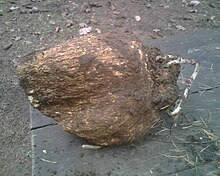Wolfiporia extensa
| Wolfiporia extensa | |
|---|---|

| |
| Wolfiporia extensa sclerotium | |
| Scientific classification | |
| Kingdom: | Fungi |
| Division: | |
| Class: | |
| Order: | |
| Family: | |
| Genus: | |
| Species: | W. extensa
|
| Binomial name | |
| Wolfiporia extensa | |
| Synonyms[1] | |
Wolfiporia extensa(syn. Poria cocos F.A.Wolf), commonly known as hoelen, poria, tuckahoe, China root, fu ling (茯苓, pīnyīn: fúlíng), or matsuhodo, is a fungus in the family Polyporaceae. It is a wood-decay fungus but has a subterranean growth habit. It is notable in the development of a large, long-lasting underground sclerotium that resembles a small coconut. This sclerotium, known as Tuckahoe or fu-ling (Chinese: 茯苓; pinyin: fúlíng), is not the same as the true tuckahoe used as Indian bread by Native Americans, which is the arrow arum, Peltandra virginica, a flowering tuberous plant in the arum family.
History
W. extensa is firstly recorded in Compendium of Materia Medica by Li, Shizhen around 16th Century, as one of the first books to record Chinese herbs. The book recorded its medicinal application in adverse urination, edema, spleen deficiency and diarrhea. W.extensa is used extensively as a
Botanical extract
Wolfiporia extensa is a source of
Medicinal Use
The polysaccharides of Wolfiporia extensa and their derivatives have garnered significant interest due to their wide range of biological activities. These compounds exhibit potent anticancer, anti-inflammatory, antioxidant, and antiviral effects , which indicate their potential for further development as therapy or adjuvant therapy for cancer, immune modulation, and viral diseases.[4]
Besides, some polysaccharides have been found to possess obvious antidepressant effects and have the ability to suppress the proliferation of T- and B-cells. Preliminary research indicates a potential for these polysaccharides in the development of antidepressant or immunosuppressive agents in the food and pharmaceutical industries.[5]
Its main ingredients, triterpenoid compounds, exhibit significant pharmacological properties such as anti-diabetic and tonic medicine. Particularly, specific components like pachymic acid, 3-epidehydrotumulosic acid, and polyporenic acid C have been shown to significantly increase hypoglycemic activity, which is traditionally used in treating hyperglycemic disorders like diabetes.[6]
In addition, triterpenoids from Wolfiporia extensa have been also found to demonstrate significant diuretic activity in rats. Specifically, tetracyclic triterpenoids from P. cocos are aldosterone antagonists that can bind to renal cytoplasmic aldosterone receptors. This action enhances the urinary Na+/K+ ratio in rats and inhibits the Na+-K+ ATPase in the kidney and erythrocytes, which reduce the reabsorption of crude urine, leading to increased urine excretion, as diuresis application.[7]
A novel immunomodulatory glycoprotein from Wolfiporia extensa is demonstrated to be capable of activating murine macrophages, cells that play a crucial role in the body’s defense against diseases, such as bacterial infections and tumor cells involved in tumor lysis and growth inhibition. This suggests its Immunomodulatory effects as a herbal remedy.[8]
Modern pharmacological studies suggest multiple neurological benefits associated with the use of P. cocos. For instance, the P. cocos aqueous extract has been found to improve long-term potentiation in the hippocampus of rats and ameliorate scopolamine-induced spatial memory impairment. Furthermore, P. cocos is a key ingredient in many traditional Chinese medicinal formulas used to manage neurodegenerative diseases.[9]
In Chinese Medicine, Wolfiporia extensa is commonly used for the treatment of primary dysmenorrhea. It is known for its clinical efficacy in activating blood circulation to dissipate blood stasis.[10]
References
External links
| Wolfiporia extensa | |
|---|---|
| Pores on hymenium | |
| No distinct cap | |
| Hymenium attachment is irregular or not applicable | |
| Lacks a stipe | |
| Spore print is white | |
| Ecology is saprotrophic
or parasitic | |
| Edibility is inedible or edible | |
